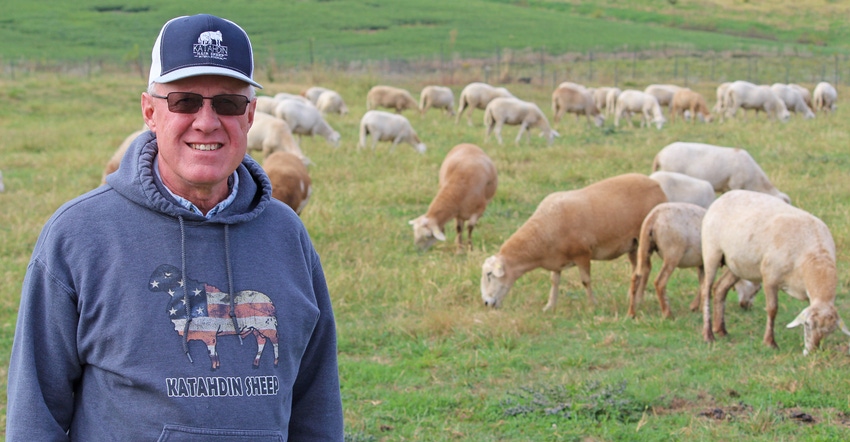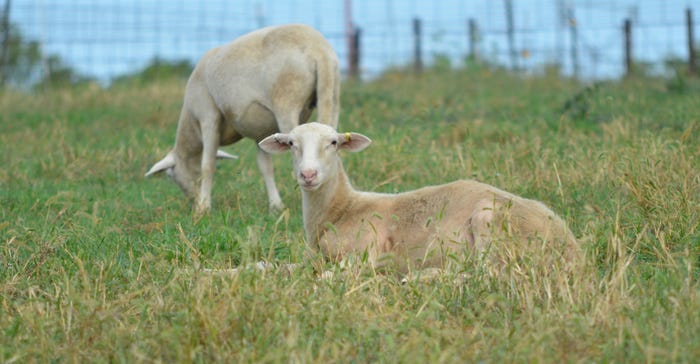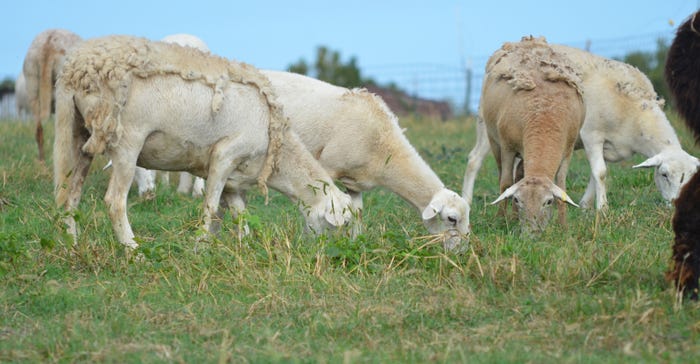
A flock of sheep graze the pasture in northern Missouri. They look like any typical hair sheep. However, this is one of 21 flocks from across the U.S. that made up the reference population for the first sheep breed in the country to have genomic-enhanced estimated breeding values.
Owner Lynn Fahrmeier says the sheep industry is embracing genetics to increase efficiency, productivity and profitability.
“This is really amazing technology that other species have had for years,” he says. “Genomic testing is a really big step forward for our breed by allowing us to describe our sheep more completely to our potential customers.”
Nearly 5,000 animals made up the reference population, says Tom Hodgman, Katahdin breed representative to the National Sheep Improvement Program.
NSIP started collecting performance data, blood samples and DNA as part of a grant in 2017. Ron Lewis, University of Nebraska-Lincoln professor in animal breeding and genomics and NSIP technical adviser, worked with his counterpart in Australia to develop the protocol, and by the end of 2021, NSIP rolled out its genomic-enhanced estimated breeding values (GEBV) for the Katahdin breed.
Rusty Burgett, NSIP program director, says this development allows shepherds to make better selections using historic data to improve their flocks.
Part of the process
For Fahrmeier, who grew up around row crops, hogs and cattle near Wellington, raising sheep was a new enterprise, one he started with his wife, Donna.
“We decided to get into the sheep industry as a side business,” he explains. “We purchased our first set of sheep — 12 ewes and one ram — in 1997.”
A self-professed data geek, Fahrmeier asked the owners for expected progeny differences on the small flock. “That was what I was used to with the cattle, but they had EPDs by breed.” The seller collected data like birth weight, weaning weight and number of lambs born. “It was helpful to us at the time,” Fahrmeier explains. “It was all we had.”

INSIDE LOOK: For so long, much of how a sheep producer bought an animal depended on production data and pedigrees, and how the animal appeared to the naked eye. However, now farmers can take a DNA sample and compare its genetic makeup to others in the industry and find the trait they need to improve their flock.
But it wasn’t enough for Fahrmeier. As NSIP board of directors chair, he was involved in the initial conversations surrounding genomics in the sheep industry. He was eager to be a part of the reference flock.
“Adding this new genomics component improves our data and ability to select animals to improve our flock,” the Lafayette County farmer says. “Now we can offer genomic-enhanced EBVs to our customers to improve other flocks.”
What is GEBV?
EBV stands for estimated breeding value and is typically derived from pedigrees and performance data, which is then fed into a computer that generates a prediction of the genetic merit of a sheep for traits such as growth, milk, prolificacy, mothering, carcass traits and parasite resistance. Simply, it evaluates the animal and predicts how an animal’s progeny will perform.
Sheep producers use EBVs as a tool in their production system. For instance, if the goal is to market grass-fed lambs, then parasite-resistance EBVs may be important. If the market calls for 60-pound lambs, improving the number born and weaned could be selected to increase profit and breeding value.
For years, sheep farmers collected data and submitted it to NSIP for EBV scoring. But with this new advancement, in 2022 all Katahdins will have a genomic-enhanced EBV.
“On average, 80% of what we measure in terms of performance is due to the environment that animal was raised in,” Burgett explains. “That environmental part doesn’t pass down to the next generation. It is the 20% that we can’t see that is controlled by genetics that will make up our next crop of new lambs. That’s the part that is passed down and what we need to try to quantify.”

BREED AHEAD: Hair sheep shed their coats in the summer. Genetics from this particular breed known as Katahdin are being used to improve flocks across not only the U.S., but also Australia.
Lewis says GEBVs provide a more accurate estimate of an animal’s true breeding value for traits shepherds are interested in. This new value system adds two data points to typical EBVs — genetic relationships and markers across the genome.
With the Katahdin reference flock, Burgett points out that some of those new genotypes were tested on a big high-density chip with 600,000 locations, and researchers found areas of interest.
“From that they whittled it down, and what we’re using now is 50,000 locations across the genome and use that information for our evaluation,” he says.
Benefits from technology
Sheep farmers will find GEBVs beneficial, particularly in young animals.
Burgett explains that in his own flock, he has a ram lamb who does not have any progeny yet to provide any insight into his production value.
“This is where genomics can really help us out,” he explains. “Adding in that DNA information can help us as we can further eliminate the environmental part that’s clouding our vision, which gives us a better estimate of that genetic potential for those traits passing on to his future lambs.”

GENETIC DETAILS: U.S. sheep farmers who raise Katahdins can now pull DNA samples to help predict an animal’s genomic-enhanced EBVs. Other sheep breeders are looking to this hair breed as an example of how to extract information from an animal that will better predict its potential in a flock.
Burgett points out that the genetic component is not going to make the animal better or worse. “But it helps you to more accurately define your sheep for your customers.” And that is what sheep producers such as Fahrmeier want.
“It is always good to be able to talk with customers and see what traits they need to improve in their flock,” Fahrmeier says. “Genomic-enhanced EBVs provide us that type of information to help in selection. It is all about building a better Katahdin breed for all sheep producers.”
GEBVs really are becoming the model for the entire U.S. sheep industry, Hodgman says. “Katahdins are paving the way for other breeds once they get their genomic reference population in place. People will look back at 2021 and say it’s where this breed took off, and never looked back.”
About the Author(s)
You May Also Like






